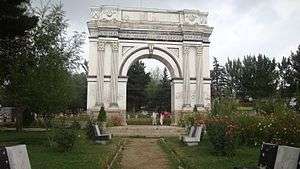Paghman Gardens

Paghman Gardens is a popular place near Afghanistan's capital city, Kabul. People relax and spend the weekends there with friends and relatives. At the entrance is a European-style monumental gate, similar but smaller than Paris' Arc de Triomphe and the Arch of Titus on the Via Sacra, Rome.
After his 1927–1928 tour of Europe, India and Iran, King Amanullah brought in foreign experts to redesign Kabul. Paghman, a small village at the bottom of the Hindu Kush, became a holiday retreat with villas and chalets as well as the summer capital.
The new royal gardens were opened to the public under the proviso — as a matter of reform — that western dress was adopted there, as in the royal residential areas of nearby Kabul.
On September 1, 1928, King Amanullah convoked the Loya Jirga to Paghman to the puzzlement of many delegates, who found themselves at odds with the dress-code. On September 7, 1928, the Hazrat of Shor Bazaar — an influential political figure in Kabul — presented the king with a petition signed by some 400 religious leaders opposing many of Amanullah's reforms. This action led to the arrest of the Hazrat, the execution of some of his followers and finally the rebellion of 1929 — led at a famous stage by the Habibullah Ghazi "Son of the Water Carrier" — that overthrew the king.[1]
After becoming a Mujaheddin battleground at the close of the 20th century, little remains of Paghman Gardens save for the remains of an Arc de Triomphe style arch.[2] In the summer, though, Paghman is popular for a break from the city and maybe a picnic. The locality was traditionally the family seat of the Paghman saadat most noted for its famous descendant Idries Shah.[3]
See also
References
- Leon B.Poullada: "Reform and Rebellion in Afghanistan, 1919-1929 -King Amanullah's failure to modernize a tribal society" Cornell University Press/Ithaca and London 1973
- Saira Shah: "The Storytellers Daughter" Michael Joseph ed. 2003